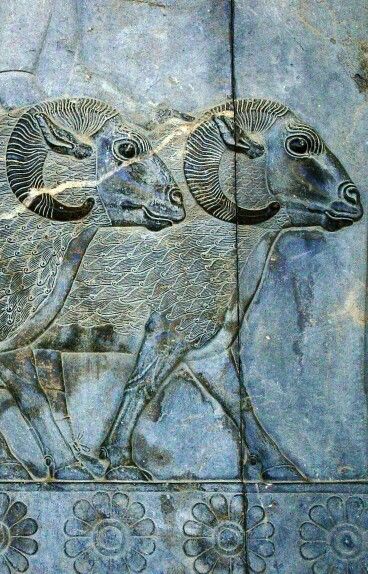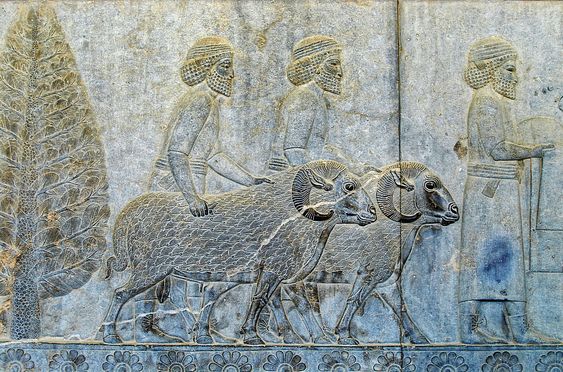By Susan MacMillan, ILRI —
Published this month in Global Food Security and led by scientists at the International Livestock Research Institute (ILRI), this paper confirms a wealth of similar evidence showing that, with sufficient and targeted investments in their livestock sectors, many low- and middle-income countries can achieve both better nutrition and incomes for the poor and greatly reduced greenhouse gas emission and agricultural water use.

Above and below: stone carving bas reliefs from the ruins of ancient Persepolis, capital city of the Persian empire, 5th Century B.C. (Photo Credit: Susan MacMillan, ILRI)
Here’s the abstract to the paper.
‘Growth in demand for livestock-derived foods will likely remain strong in low- and middle- income countries, fueling concerns about expansion of production and the management of natural resources. Recent research suggests that the envisioned negative effects are not inevitable and that benefits such as improved food security can be enhanced. Targeted investments to the livestock sector could help make these happen. We use scenario analysis to explore this question, assessing the impacts of selected investment options in sub-Saharan Africa and South Asia. Our results show that boosting livestock productivity primarily in these two regions could improve food security and producer incomes while limiting greenhouse gas emissions and agricultural water usage. Market-improving investments with similar welfare gains lead to environmental impacts that necessitate complementary investments.’

(Photo Credit: Susan MacMillan, ILRI)
Key to strategic investments in the global livestock sector, the authors say, is to offer opportunities for sustainable expansion of the sector, with improved resource efficiency, secured social equity and strengthened resilience of the underlying production systems are key elements. (For more on that, see, for example, Sustainable Agricultural Development for Food Security and Nutrition: What Roles for Livestock?, A Report by the High Level Panel of Experts on Food Security and Nutrition of the Committee on World Food Security, Rome, 2016, https://hdl.handle.net/10568/76163.)
This new assessment focuses on South Asia and sub-Saharan Africa, ‘two regions with high levels of poverty, hunger, and malnutrition and where there is substantial potential for livestock-sector led rural development.’

(Photo Credit: Susan MacMillan, ILRI)
‘. . . Of the around 766 million poor people (i.e., those living on less than two US dollars per day) that derive direct incomes from livestock, more than 70% live in South Asia or sub-Saharan Africa (Robinson et al., 2011), highlighting the importance of the livestock sector as a vehicle for pro-poor economic development in these regions (Staal et al., 2009, Otte et al., 2012). An assessment of poverty reduction strategies for East and Central Africa showed that the greatest effects would come from subsectors including livestock for which the growth in food demand is highest (Omamo et al., 2006).
‘In South Asia, one of the premises for the sector’s potential as an engine for growth is that the current distribution of livestock is more egalitarian than that of other assets, such as land. For example, more than 70% of rural households in India own livestock and a majority of these are small, marginal, or landless (Ali, 2007). In both South Asia and sub-Saharan Africa, livestock is also known to make substantial contributions to household nutrition and to the livelihoods of poor women (Herrero et al., 2013a, Kristjanson et al., 2014). . . .
‘According to Herrero et al., 2013a, Herrero et al., 2013b, increasing the efficiency of the livestock sector in lower income countries presents real opportunities for more sustainable sector development in these countries. Key among sector-enhancing strategies is improving the performance of livestock animals. In both South Asia and sub-Saharan Africa, technological breakthroughs in animal genetics, animal health, and feed and nutrition are considered necessary to improve livestock productivity, and to enhance resource use efficiencies (Birthal and Taneja, 2012, Cardoso, 2012, Pradère, 2014, HLPE, 2016). Studies such as Omamo et al. (2006) and Birthal and Taneja (2012) further emphasize the importance of improving market efficiencies to reach the pro-poor potential of the livestock sector in these regions. . . .
‘Results suggest that the expansion of regional production in both regions does not need to follow a path of massive increases in farm animal numbers. Research funding targeted to closing livestock yield gaps make it possible for growth in animal herds or flocks to be more conservative, reducing pressures on agricultural water use, and leading to lower GHG emissions, compared to a situation with no such investments. . . .
‘While additional analysis is needed to ascertain potential levels and distributional effects of impacts, what emerges from this and previous research is that direct investments to improve animal productivity, e.g., through technological advancement and context-adaptation of livestock genetics, feeds and animal health solutions, have potential as integral components of development strategies to enhance human welfare and natural resource management. . . .’
This article is drawn from the original post on ILRI's website.
Full paper can be accessed and downloaded here.
______________________________________________________________________________________________________________
This work received direct funding support from the CGIAR Research Program on Policies, Institutions and Markets (PIM) through the Global Futures and Strategic Foresight (GFSF) Project. Open access was provided by PIM. The authors also acknowledge support to the CGIAR research programs on Livestock Agri-Food Systems (DE, KMR, SS), Climate Change, Agriculture and Food Security (PT) and Water, Land and Ecosystems (MM), from the CGIAR Fund Donors, France (https://www.cgiar.org/funders/) and through bilateral funding agreements.
Read the new science paper, Supporting sustainable expansion of livestock production in South Asia and Sub-Saharan Africa: Scenario analysis of investment options, written by Dolapo Enahoro (ILRI), Daniel Mason-D’Croz, Marloes Mul, Karl Rich (ILRI), Tim Robinson, Philip Thornton (ILRI) and Steven Staal (ILRI), Global Food Security, Mar 2019.





